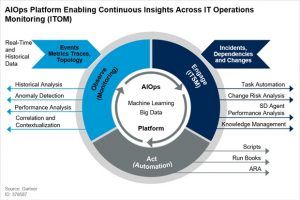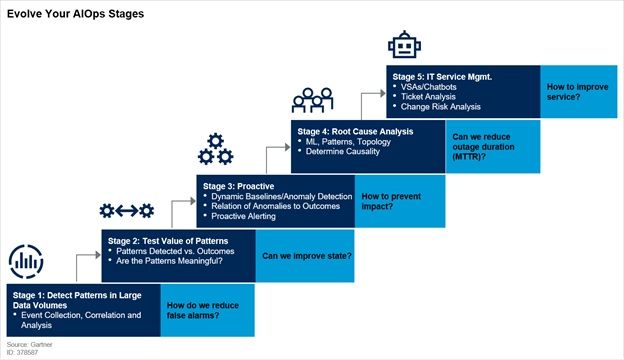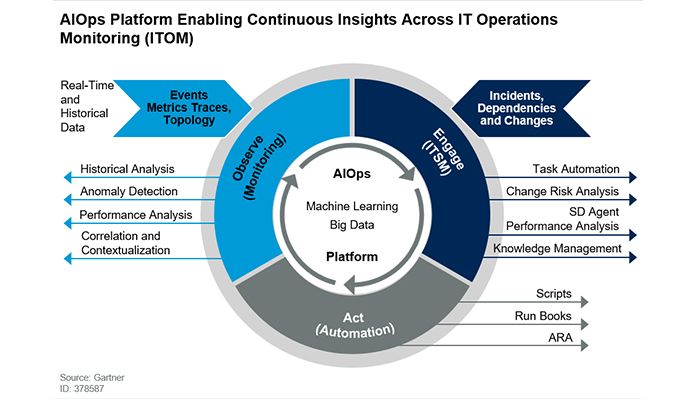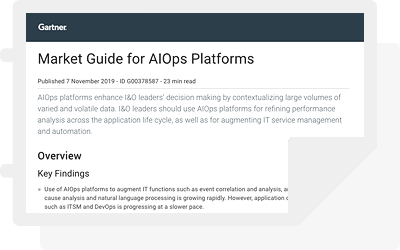Gartner recently release the 2019 version of the Market Guide for AIOps Platforms. Key findings of the guide show that, while still in the early stages of adoption, AIOps is growing rapidly. The market guide includes new insights into the potential that machine learning and analytics has to positively impact IT Operations and organizations overall.
(For anyone new to the concept, check out our introduction to AIOps.)
Like Gartner, who report a 25% increase in end user inquiries on AIOps, we at BMC Software are also experiencing increased interest from customers who are challenged by increasing complexity and volumes of data which are beyond human scale to manage. Leaders recognize that the combination of big data, machine learning, analytics, and automation has potential to:
- Transform monitoring and event management
- Drive significant benefits across IT Operations practices
AIOps Trends
So, what are Gartner saying are the major changes in this updated 2019 Market Guide for AIOps? Here’s my top 3 take-aways:
- Implement an AIOps strategy that covers the three aspects of Observe, Engage and Act and pursue a staged approach to adoption based on prioritized use cases.
- There is significant potential to derive increased value by integrating AIOps to ITSM processes.
- The evolution of the vendor side of the market towards ‘domain-agnostic AIOps’ vs ‘domain-centric AIOps’ and the corresponding organizational priorities they serve.
Let’s look at all 3 of these.
1. Gartner advice for AIOps adoption
Gartner has segmented the requirements of AIOps platforms across three areas:
- Observe
- Engage
- Act
With this, they are underlining the importance of having the capability to ingest large volumes of diverse data sets and apply machine learning and analytics.
Another key requirement is the capability to engage other IT disciplines and enable action to be taken on the rich insights delivered in impactful ways that deliver value to the business. While monitoring and observability is the essential foundation of a successful AIOps strategy, the true game-changing value comes from engaging and acting on the data.

2. AIOps and ITSM
An important update in this new 2019 version of the Gartner Market Guide is the recommendation to choose “an AIOps platform that can be applied to key ITSM use cases” with a focus on driving automation and triage and remediation of problems. Here, Gartner is emphasizing the importance of the link between monitoring, service management and automation tasks in the deployment of a successful AIOps strategy.
As the IT disciplines of ITSM and ITOM overlap more and more, machine learning and analytics can be an essential enabler of that convergence. With a holistic AIOps strategy that works across the 3 areas of Observe, Engage and Act, effective integrated use cases can be implemented across ITOM and ITSM for automated event remediation, incident and change management and intelligent ticketing and routing. At BMC, we call that proactive service resolution: the ability to discover, monitor, service, and remediate events as they occur
Getting to the point of having actionable insights from machine learning and data analytics that support automated workflows is an important development for IT Operations teams that will drive real value from all this data intelligence. Successfully executing on this will require robust integrations to orchestration tools as well as the CMDB for service impact mapping. The visibility, intelligence, speed and insights that AIOps brings can revolutionize these latter stages of monitoring and drive significant benefits.
3. Requirements of AIOps Software
Gartner segments AIOps offerings into ‘domain-agnostic’ and ‘domain-centric’, pointing out that there is likely to be overlap between the two within implementations. We certainly see this amongst our customer base – domain-centric AIOps tools may be used for specific best-of-breed use cases and data and events from those tools are consumed by the BMC domain-agnostic operations management solution to deploy the machine learning, analytics, ITSM engagement and automation for the required use cases.
Gartner lists the key capabilities of an AIOps platform to support the full spectrum of Observe, Engage and Act:
- Broad Data Ingestion & Handling. All organizations are operating in highly complex environments and need to be able to ingest data, events and metrics from many different sources
- Deploy Machine Learning and Analytics for event correlation, pattern discovery and prediction, anomaly detection and root cause determination. The most important aspect of this is how machine learning and analytics supports required use cases.
- Remediation. Leverage prescriptive advice to take automated action to resolve events and bridge ITOM and ITSM processes
Leveraging an AIOps platform that unifies data from many sources into a single view and enables pattern identification, analysis and contextualization within a single solution with actionable ways of applying machine learning and analytics to event management challenges is clearly the way forward for IT Operations teams.
In this age of cloud, hybrid infrastructures, digital initiatives and rapidly changing technology landscapes, the IT Operations function has never been more important to the ability of IT to support the business. The most successful IT Operations teams will be those who can leverage new AI capabilities in both a strategic and tactical way to drive efficiencies, cost reduction and speed throughout IT processes.
AIOps use cases
Gartner continues to recommend focusing on a staged AIOps adoption approach by adopting specific use cases that improve specific business outcomes. A good starting point is to use machine learning and analytics to identify patterns that can then serve as a driver of event predictions and automated event resolution. Once these essential patterns are identified, AIOps use cases can be prioritized based on business needs including:
- Baselining of data based on dynamic thresholds instead of static thresholds to cut down on event noise and surface the most important events for triage, driving efficiencies and cost reduction
- Anomaly detection to predictively alert on potential events and triage these before business impact
- Event correlation and Log analytics to quickly perform root cause analysis and reduce MTTR
- Orchestrated workflows for automated event remediation of commonly recurring events with links to ITSM for incident and change management
“Ensure that your use cases drive action to improve business outcomes and that the result of AIOps platform output is either a manual next step or the launching of a script or run book to improve the current state.” – Gartner Market Guide for AIOps Platforms, November 2019
Many IT Operations teams who have until now resisted the adoption of AI capabilities for various reasons can benefit from following a phased approach and, as a first step, start to get visualization of and conduct analysis on the operational data being collected to identify patterns with a view to implementing more advanced AIOps use cases.
Here’s an example from the Gartner Market Guide for AIOps platforms on how an IT organization could move through a staged use case adoption approach:

BMC for AIOps success
BMC Helix is the first and only end-to-end service and operations platform that unites Discovery, Monitoring, Service Management, Remediation and Optimization in one solution with embedded pervasive intelligence to turn unknowns into knowns for a successful AIOps strategy.
Additional resources
For related reading, exploring these resources:







